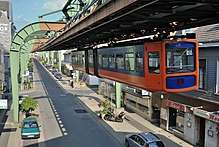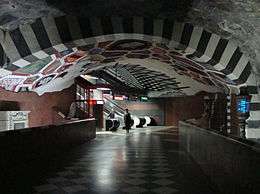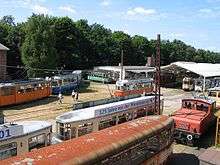Public transportation
Public transportation is organized passenger transportation. It is usually provided by buses and rail systems, including rapid transit as well as light rail, funiculars, monorail, and other modes of transport.
- This article is about local travel. For information on long-distance trains and buses, see Rail travel and Bus travel. For transportation systems which are an attraction in their own right, See urban rail adventures.
Depending on the country, commuter rail can be virtually identical to longer-distance trains while mostly fulfilling an urban rail role. Ticketing can be integrated with railways (e.g. in Germany) or separate (e.g. in the US).
While comfort and reliability vary a lot, it is usually the most practical way to get around in large cities.
Understand
| “ | An advanced city is not one where even the poor use cars, but rather one where even the rich use public transport. | ” |
—Enrique Peñalosa, Mayor of Bogotá | ||
Most urban rail systems are part of a government-subsidized public transport network and many carry large numbers of passengers, especially in larger cities; the Tokyo system averages over 8 million a day and Shanghai almost 7 million. These systems therefore almost always cost less than taxicabs and are often both faster than driving and cheaper than paying for parking. However, there are fairly often problems with overcrowding, especially at rush hours. So as Yogi Berra used to say - it's so crowded, nobody goes there.
With oil prices generally on the rise, and political concern for environmental protection and CO2 emissions becoming more and more important, almost all countries and cities that have rapid transit systems are in the process of upgrading, modernizing and expanding their networks sometimes very rapidly. Unfortunately, this can also mean construction sites that slow down traffic, and information about a public transit system can be outdated despite being only a few years or even months old.
The urban rail system is usually extended by buses, in some cases within the same ticket system. On the other hand most urban rail systems of more than token size serve the city's mainline train station(s) (often having a hub at one or several of them) and integrated tickets are becoming increasingly common. Sometimes a train ticket already includes one ride on the urban rail system of your departure and/or origin city to enable "door to door" travel. This is true for instance for all train tickets in Germany that have "+City" printed on them.
Types of public transportation
Public transportation is provided by many different vehicles.
- Especially in suburbs and smaller cities, the public transit network is made up by buses.
- There are variants of Bus Rapid Transit (BRT) where buses have dedicated infrastructure. Much of Ottawa's system uses buses on dedicated roads called the Transitway while cities such as Xiamen have Bus Rapid Transit using elevated bus-only roads. Not all such traffic runs on bus-only roads; often some lanes on normal roads are restricted to buses, at least during rush hours, and in some systems the core has special roads but out at the periphery the buses continue via normal roads. Given the inherent perception of the term, BRT is sometimes applied by local government or opponents of rail transit as a term for systems hardly distinct from regular bus systems.
- Rapid transit or metro is a local passenger rail network with grade separation from other traffic. The terms subway and underground indicate that many rapid transit lines go below ground. However, by no means all transit lines are underground (regardless of name); elevated and surface rail is widely used as well. Fully grade separated rail systems are the only ones to commonly be operated automatically.Double-decker tram in Hong Kong
- Light rail typically moves at ground level, often with small vehicles of shorter range that are known as trams or streetcars: tracks can either be in the street, or on a separate trackbed. While the first trams in the early 19th century were horse-drawn or steam-powered, many cities worldwide either replaced them with electric streetcars or built new systems from scratch towards the end of the 19th century, but with the rise of the automobile many fell from favor and were either removed or left to disintegrate. Now, however, with the increased popularity of public transport in much of the world, many cities are re-instating and re-invigorating their tram systems for the 21st century. Some notable examples of cities with light rail networks are Barcelona, Cologne, St. Petersburg, Berlin, Denver, Vienna, Manchester, Melbourne, Hong Kong, San Francisco, and Toronto. In Belgium one single line connects the entire coast end to end. Streetcars experienced a renaissance starting in France in the 1970s and many cities in Europe now have comprehensive systems that are often not only the cheapest and most environmentally friendly but also the fastest way around town. Central and Eastern Europe also tend to have dense networks as they were slower in dismantling their streetcar systems and are almost universally reinvigorating and modernizing their systems, sometimes even building new lines that run on dedicated tracks.
- Commuter trains are local passenger trains, either on the national rail network, or on dedicated regional networks. While commuter trains are usually part of the local transit ticket system, furnishing is minimal; toilets and refreshments are usually absent. The German term S-Bahn has spread to other German-speaking countries as well and inspired terms such as Esko (Prague) or S-Tog (Copenhagen). In North America commuter train systems are often known by the acronym of the governing authority, e.g. BART (Bay Area Rapid Transit) in the San Francisco Bay Area and GO trains in the Toronto region.
 Wuppertal Suspension Railway
Wuppertal Suspension Railway - Unusual forms of rail are sometimes used, for single lines if not whole systems. For example,
- Seattle built an elevated monorail line for the 1962 World's Fair that is still in service;
- Chongqing has several monorail lines; Shanghai has a magnetic levitation line to Pudong Airport with speeds over 400 km/h (250 mph);
- the German city of Wuppertal has had a suspension railway since 1901; and
- Morgantown, West Virginia, USA, has a Personal Rapid Transit system.
- Some very hilly cities and a number of cities in developing countries also use funicular railways or aerial passenger tramways. While they often offer spectacular views and may be the only way to get up steep slopes, their maintenance may prove challenging. Cities with such systems include Dresden and Medellin.
- Trolley-buses don't run on rails either but as their motive power is provided through overhead wires, their mobility is tied to a pre-built network much like that of systems running on rails. They were an important part in public transport in the former eastern bloc and remain important in those countries as well as in Canada and Switzerland.
- While escalators and elevators are usually set up for indoor transportation, they are part of the public transport system (sometimes with a ticket required) in some hilly cities such as Hong Kong and Valletta.
- Ferries are used for public transportation in insular locations such as Venice or the Stockholm archipelago.
Each of these methods is used in some cities, and it is fairly common for a single city to combine several. For example, Shanghai's system mainly uses underground rail lines downtown and elevated lines in the suburbs, and it also includes an extensive bus network, a fast magnetic levitation rail line to Pudong Airport and a tram system in one suburban neighborhood.
Nearly all such systems offer convenient connections to other transport. For local travel, most metro stations have bus or tram stops nearby, some have a major terminus for buses or trams, and many have a taxi stand. For long distance travel, nearly all rapid transit systems offer convenient connections to railway stations and airports. In London, for example, all the railway terminals and Heathrow Airport are on the underground, and the other airports can be reached by trains which depart from underground stations.
Get in
There are various methods needed to get into urban rail systems in different cities. In many cases, some form of plastic card or paper ticket must be tapped, swiped, or inserted into a machine for riders to be able to enter the platform legally. In some cases there is even a physical barrier. In other cases, it can be perfectly legal to access the platform without having first purchased a ticket, but riding the train without buying a ticket from a ticket machine on the platform and validating it by inserting it into another machine that stamps or perforates it could incur a heavy fine.
Get out
There are also different ways to leave the system. Some systems require riders to tap or insert a card or ticket into a machine before leaving the system, too, while others put no impediment whatsoever in the path of departing commuters or simply require them to walk through a door or turnstile.
What riders may carry

There are all sorts of different regulations as to what you may or may not carry into a train and whether it does or does not incur an additional charge. Many subway systems allow riders to carry bicycles with them onto the train, at least outside of rush hours, but it is not always free for your bicycle to ride with you. In Berlin, for example, bicycles are welcome anytime but require a separate bicycle ticket, on penalty of a large fine. Dangerous objects such as knives might be prohibited.
Singapore's MRT is one of several South-East Asian transit systems that includes a sign showing a durian with a line through it, the quasi-international sign for "No durians allowed!" The fruit is quite tasty and is popular throughout the region, but it smells awful.
Public transport systems often have harsher rules of order than other public areas, usually banning alcoholic beverages, but this varies between different systems. Travelling with pets may be restricted: for example, some systems such as New York's require all pets to be brought in carriers, rather than merely leashed or hand-held, though small dogs that can fit in a handbag are OK as long as they stay there. In German cities such as Berlin, however, a single ticket is specifically noted to be good for one person and one dog (extra reduced-fare tickets are needed for additional dogs), and dogs need only be leashed. Regulations for service animals are quite often more liberal than regulations for pets, and form part of the national and/or local policy on the rights of disabled people.
See
- See Urban rail adventures for urban rail systems beyond the usual.

The oldest large systems in the world (the London Underground, New York City Subway, Paris Metro, Berlin U-Bahn, Moscow Metro...) have many historical stations that are masterpieces of architecture and design in their own right. For example, Paris' famous Art Nouveau station entrances, London's Art Deco ticket halls and Moscow's cathedral-like platforms are seen as integral parts of their respective cities' heritage.
Some rapid transit systems, such as Moscow, Stockholm, and New York City have public art on permanent display, making them interesting destinations in their own right.
Some systems also display short poems or excerpts from longer poems and descriptive prose in train carriages, which was started by the London Tube as "Poems on the Underground", continued by the MTA as "Poetry in Motion" on New York's Subway and adopted by other mass transit systems around the world.
Riding on systems with elevated lines can be a cheap and cheerful way of seeing the sights of a city from a good vantage point instead of forking out for a costly open-top bus or river tour. Notable examples include much of Chicago's L system, lines 2 and 6 of the Paris Metro and the Docklands Light Railway in east London.
One inherent advantage of light rail over underground systems are the better views and there are often routes that are worth taking for the views alone.
Do
Performances
.jpg)
Some rapid transit systems are well known for buskers or more formally organized performances. Among the systems where you can hear some high-quality performances by buskers in corridors are the London Tube and the Paris Metro. New York City is one of the places where there is a formal system for selecting approved performers. Every year, there are auditions at Grand Central Terminal for Music Under New York, which gives artists a chance to perform on a regular schedule without hassles by the police, while they display the official logo of the program. The London Underground also has designated sites in prominent areas where licensed buskers can perform.
Stay safe
Pickpocketing is common on public transportation. Follow the usual principles: Try to avoid displaying yourself as an out-of-town traveller, don't carry more baggage than you can keep track of, keep valuables near your body, and never put anything you don't want to lose in your back pants pockets or jacket pockets, only your front pants pockets or a money belt.
Another hazard of some rapid transit systems, especially in crowded trains, is molestation. It's to be expected that in very crowded systems during rush hour, people will be mashed against each other, but that is no excuse for someone to deliberately touch a stranger's private parts. Some rapid-transit systems, such as in Tokyo and Dubai, have women-only areas. Others, like New York's, post and play announcements against molestation and advise victims not to remain silent. If you are being molested in a crowded metro car, speak up, and the rest of the passengers will generally support you.
An obvious danger is falling onto the tracks. These (or a third rail on the side) are often electrified, so touching them can be fatal. Additionally, being struck by a train is also likely considering the high frequency of services. If you accidentally drop anything onto the tracks, inform the station staff and make no attempt to retrieve the item yourself, no matter how valuable it is.
Many rapid transport systems have installed automatic doors between the platform and the tracks, such as in Seoul, Tokyo, Hong Kong and Singapore. This is done for general safety and also to prevent suicides. However, do not be surprised if some stations on a network lack such doors.
Generally speaking, if you get stuck in a train door owing to a crowded compartment, the train will not move and will open the door again. However, there have been cases, such as in Shanghai, when people have died after the train started to move whilst they were caught in the door. Do not rely on such safety measures. This is especially important if you travel with children, whose limbs may be too thin to be detected by the system. In buses, the drivers view may be obstructed by the crowd so that a child is hard to see.
Crowding is a risk factor for all of the above. If you have the chance, avoid rides during rush hour (usually 07:00-09:00 and 16:00-18:00 at weekdays), or wait for a train that is less crowded, and do yourself and everyone else a favor.
Security routines on stations and on board are usually harsher than in other public places. Staff might forcefully eject passengers for intoxication, antisocial behavior, or for absence of a proper ticket.
Articles on public transit systems
- Trams in Melbourne
- Public transit in the Bay Area
Museums covering urban rail

- 🌍 Cable Car Museum. San Francisco (in Nob Hill)
- 🌍 Glasgow Riverside Museum, 100 Pointhouse Place, Glasgow, Scotland UK (subway: Kelvinhall), ☎ +44 141 287-2720. The museum includes a recreated subway station.
- 🌍 Halton County Radial Railway, 13629 Guelph Line, Milton (15 km N of Hwy 401, northwest of Toronto, Canada). A working museum of electric streetcars (trams, other railway vehicles, trolleybuses and buses. 3 operating historic streetcars on 2 km of scenic track, display barns and historic Rockwood Station.
- 🌍 Hanover Tramway Museum, Hohenfelser Straße 16, 31319 Sehnde, Germany (near Hanover). The museum presents the only nationwide collection of trams in Germany.
- 🌍 London Transport Museum. London (in Covent Garden)
- 🌍 Melbourne Tram Museum (Hawthorn Tram Depot). Melbourne, Australia (in the Eastern suburbs)
- 🌍 National Tramway Museum, Derbyshire, UK. Also known as Crich Tramway Village
- 🌍 New York Transit Museum. Brooklyn, New York City (in Downtown Brooklyn)
- 🌍 Stockholm Transport Museum. Södermalm, Stockholm
- Swedish Urban Transport Museum (Malmköping, north of Flen). Though Malmköping is barely a town, it hosts streetcars from most Swedish cities.
- 🌍 Sydney Tramway Museum, Rawson Pde, Loftus, Greater Sydney, Australia (Adjacent to Loftus Railway Station, no entry from Metroad 1 heading south). Su W 10AM-5PM. Additional days school holidays. They have an old Bondi tram, overseas trams, and tram rides, including rides to the Royal National Park. They also have a large display area.
- Shanghai Maglev Museum, Longyang Road Station, Pudong, Shanghai, China (Directly above Longyang Road metro station (Lines 2 & 7)). The Maglev is the fastest train in the world, going at up to 430 km/h and taking 8 minutes to travel the 40 km to the airport. A museum dedicated to this technology is built inside the Maglev station.
Other options
Other options can provide more comfort or flexibility; such as urban cycling, taxis, or guided tours.